A significant feature of the tortoises is so often referred to as "An Imitation of Life". As well as their behaviour, the tortoises construction had to be such that autonomy could be exhibited. This is somewhat driven by the technology and parts available at the time. For Grey Walter's purposes, the models had to be self-contained and as light as possible for transportability.

BATTERIES
also referred to as "Accumulators"
also referred to as "Accumulators"
Pre 51 “Elsies” had 45 Volt 'Ever Ready' “B” batteries designed for 2-vacuum tube hearing aids. You can see the words “Hearing….” in some of the pics of the tortoises internals. The colour of these (Red ends, white sides and corners) suggests war-time Ministry of Health HT (High Tension) battery.
We also know, from the Festival of Britain – Exhibition of Science of 1951 catalogue, that the batteries used in the batch of 6 were 'Exide' accumulators, "Gel-cel" PRA 3S made by Chloride Batteries, 45-V batteries, "Batrymax" B109 made by The Ever Ready Company (Great Britain) Ltd.
[ Note: RH 2009 – Its interesting that Gel Cels were around then, being a motorcyclist myself, I thought they were a relatively recent invention.]
[ Note: RH 2009 – Its interesting that Gel Cels were around then, being a motorcyclist myself, I thought they were a relatively recent invention.]
In the circuit schematics for M. Speculatrix, you will notice the on-off power switch is only on the 6 V side. The Vacuum tubes (also known as valves), don't function unless the heaters are on, and the heaters are on the 6 volt circuit. However, we know from notes on usage of the tortoise that the plug for the "B" battery is disconnected during transit. An article by F.H. George (John Bull 1956) informs us of how George heard noises coming from the hutch when transporting the tortoise from a demonstration. It had accidentally turned itself on and was looking for light inside its closed hutch.
RE-CHARGING
Pierre de Lati mentions in his book Thinking by Machine, 1957, mentions of an "ingenious mechanism" and comments of "going back to the hutch to feed". He elaborates further in the section "The Secrets of the Tortoises" when he says "As soon as the tortoise is in its hutch, in contact with the mains, the voltage of this current cuts off the contact A which link the accumulators to the mechanism; they recharge instead. But when the accumulators are charged up to 7 volts, the relay R4 makes contact again at A and the tortoise moves away, since now that it is replete it has regained its movement and will avoid bright light". (See diagram below). This is achieved using a special relay wired in a particular way. These are labeled R3 and R4 in the schematic. They are in fact a single unit described below.
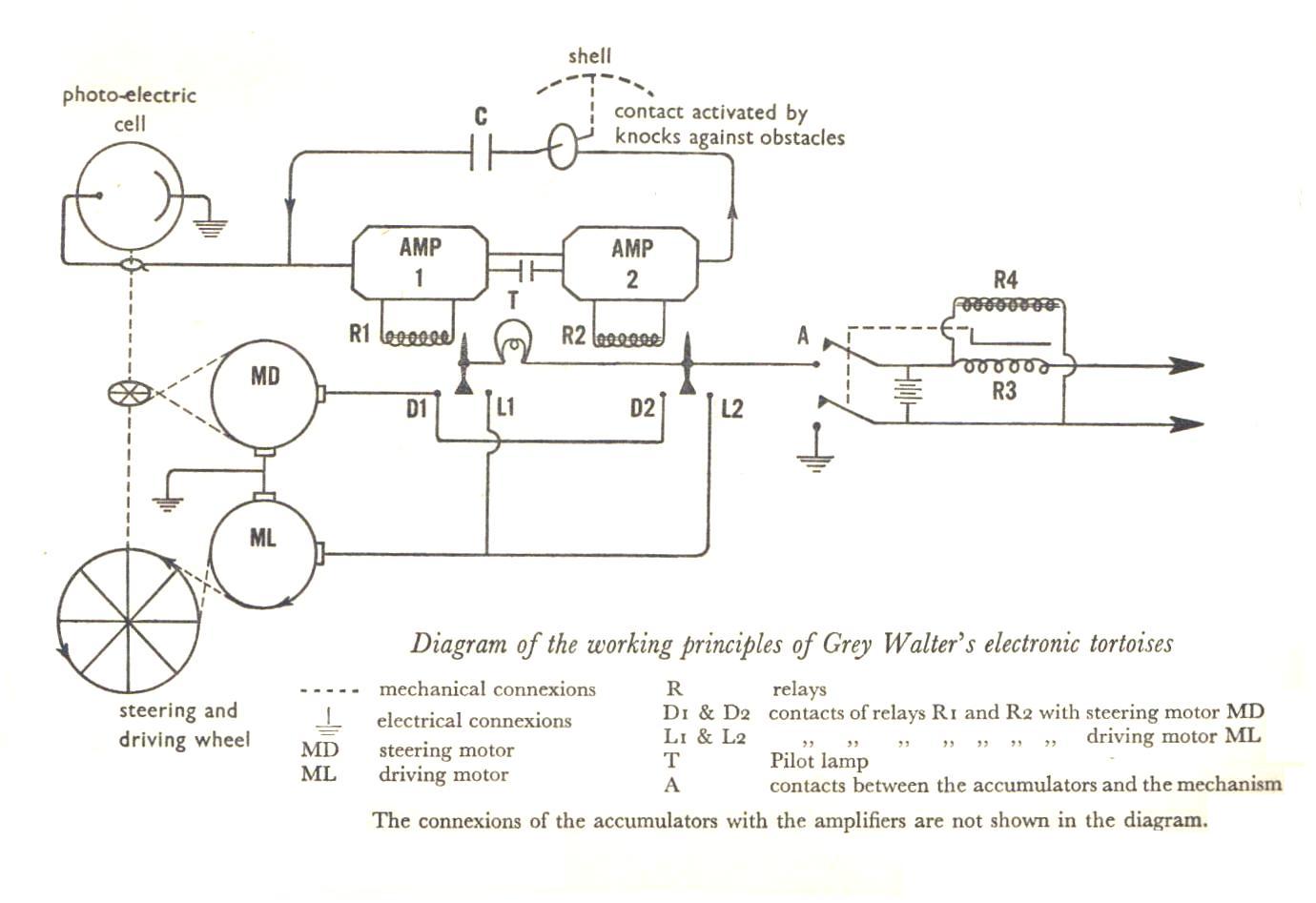
The relay used in the re-charging circuit is a different type of relay than more common types, it's a two-coil relay (sometimes referred to as a double-coil relay).
One coil in series with the supply switches the supply to the motors OFF when the battery starts to charge, so immobilising Elsie, as the charge current reduces and the voltage rises the other coil takes over and restores the supply to the motors. So Elsie then backs away from the intense light in the hutch. “Double-coil" relays – these relays are so constructed that if the current through both coils is the same, the clappers are such that the contacts remain open. If the current through one coil is greater by a sufficient amount than that through the other, the clappers will move in unison, making contact.” – Kubanoff's Timothy Turtle, 1953. Note: The re-charger for Timothy Turtle charges through the solenoid (i.e. one of the solenoid wires is connected to one of its own contacts.) The relay closes due to this current and remains closed until the condenser (i.e. battery substitute) is charged/re-charged. It would need the two coils to reduce the lock-in effect of just one in the supply line. By following the circuit diagram of deLatil's, you can also see the contact wiring connected to the coils. Normally relays are wired such that coils are isolated from the switching circuit.
One coil in series with the supply switches the supply to the motors OFF when the battery starts to charge, so immobilising Elsie, as the charge current reduces and the voltage rises the other coil takes over and restores the supply to the motors. So Elsie then backs away from the intense light in the hutch. “Double-coil" relays – these relays are so constructed that if the current through both coils is the same, the clappers are such that the contacts remain open. If the current through one coil is greater by a sufficient amount than that through the other, the clappers will move in unison, making contact.” – Kubanoff's Timothy Turtle, 1953. Note: The re-charger for Timothy Turtle charges through the solenoid (i.e. one of the solenoid wires is connected to one of its own contacts.) The relay closes due to this current and remains closed until the condenser (i.e. battery substitute) is charged/re-charged. It would need the two coils to reduce the lock-in effect of just one in the supply line. By following the circuit diagram of deLatil's, you can also see the contact wiring connected to the coils. Normally relays are wired such that coils are isolated from the switching circuit.
ANTENNAE
Its quite possible that the early version of the tortoises antennae may have been the contacts for the automatic re-charging capability.
Elmer – none at all but with jacks mounted on the rear of its segmented shell; Early Elsie had wire antennae from top ‘metal’ shell.
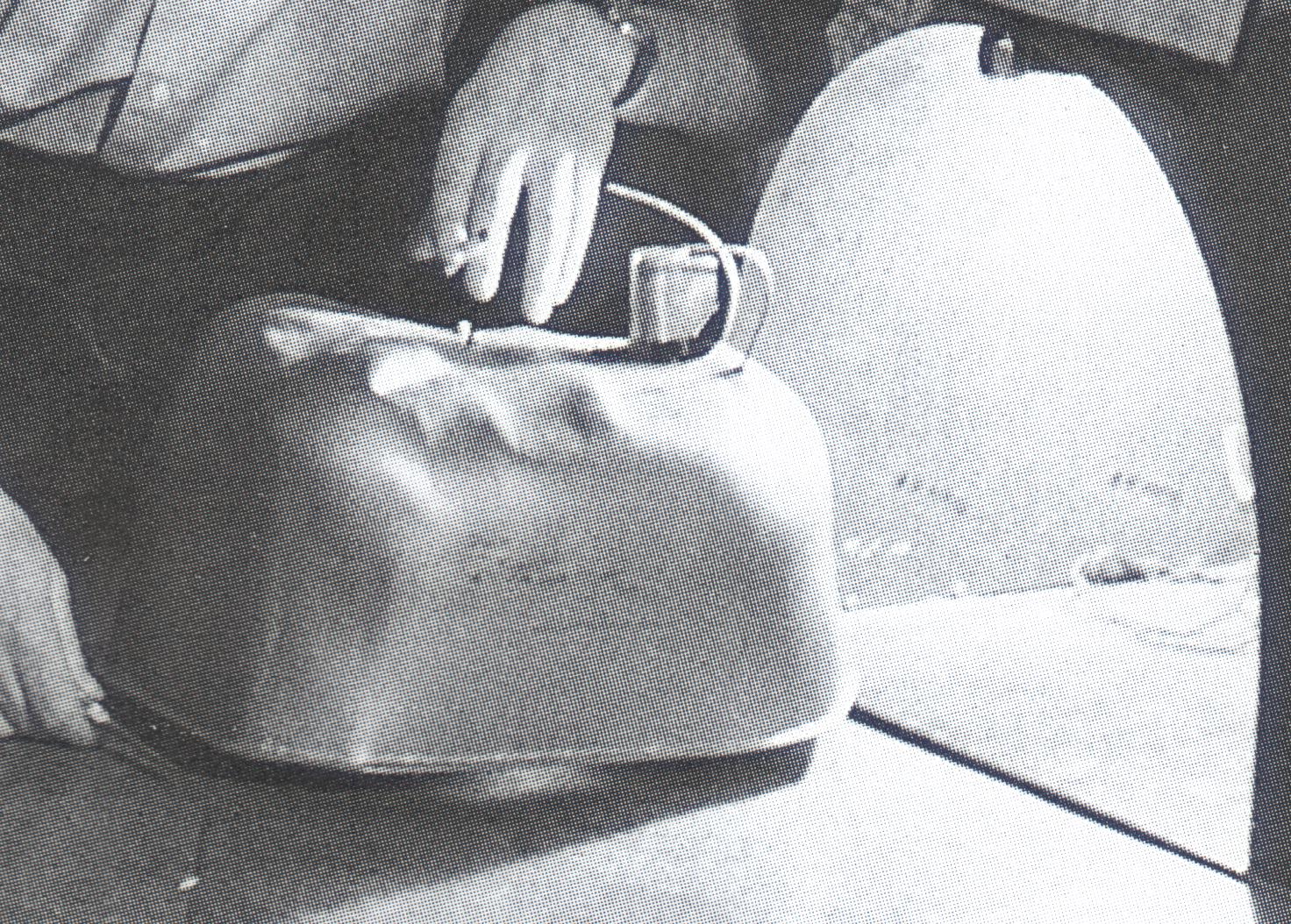
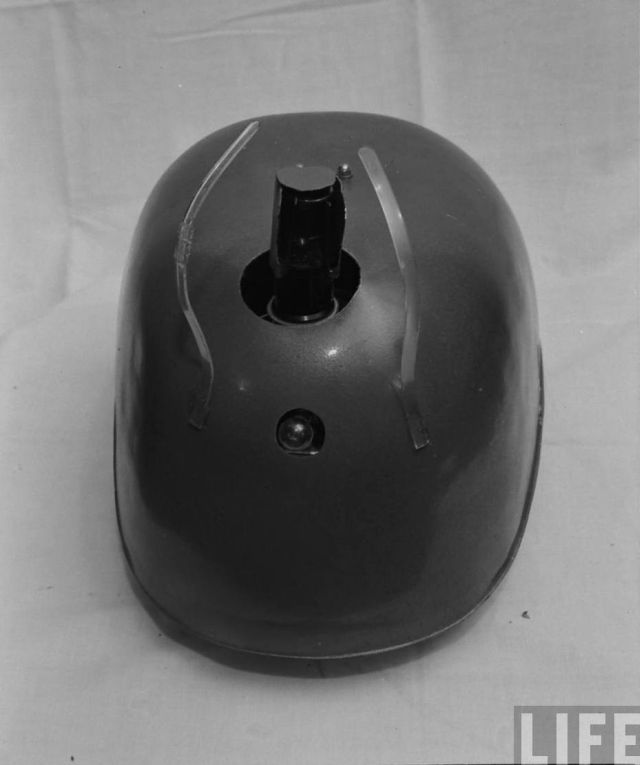
Later antennae appear to be clear plastic curved strips (ref. Time Life pic above) They even appear to glow a little, not sure if this affects PEC or not. Later the transparent antennae are removed and we just see the remaining 'holes'.
Of the ‘batch of 6' from 1951, we see the copper tube extension for the on-off switch. For those models without a hutch, this tube is largely for convenient finger control. However, to simulate the earlier automatic re-charging system and to ensure motors, etc. don’t overheat if Elsie entered the hutch and thrashes about in ‘hunger’ mode at the end of the hutch, Walter appears to have installed a metal trip bracket on the RHS (facing inwards). (see colour pic) So with the copper extension trip lever appropriately positioned, and the clockwise steering, Elsie will bump along the RHS until the switch is tripped.

In viewing some earlier film footage, we actually see the deft hand of WGW switching the tortoise off as it enters the hutch before closing the hutch door. A later film clip c1972 shows '#6' entering the hutch on the LHS. The trip bracket can't be seen in this clip. This aspect is pure speculation by me, but maybe Owen Holland, current custodian of the Hutch, could have a look to confirm.
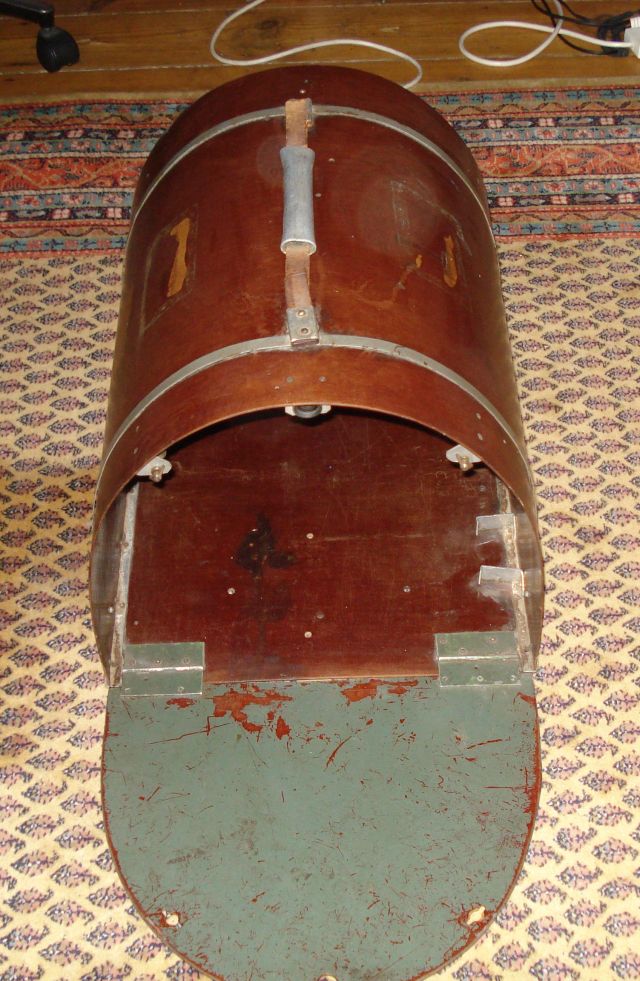
**Update 13 Jan 2011 from Owen Holland – "…the positioning of the stops on the right hand floor which would switch off the tortoise as it entered (see attached picture above). This worked most times when we tested it some 15 years ago with the tortoise that's now in the Science Museum."
THE HUTCH
We know from Owen Holland, probably in discussion with "Bunny" Warren during the restoration of Grey Walter's own tortoise, that there were two hutches built, the first having caught fire. They are easy to pick in the photos, as the first version does not have a door whereas the later model does.
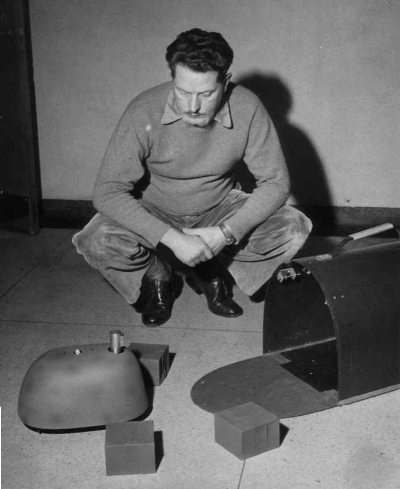
It wouldn't surprise me if the fire was as a result of the automatic re-charging facility. I mentioned above the wire-looking antennae on an early version of ELSIE. There may have been an overhead wire set-up (similar to electric trams) where the antennae contacted different overhead wires that were those of the battery charger.
In any case, I have not seen any photographic evidence of the battery charging circuit mounted on ELSIE. I believe it was, but for only a short period of time. Thereafter, it is just "assumed" that it does exist.
**Update: 14 Jan 2011** Owen Holland sent me an email saying that when he met "Bunny" Warren, he mentioned that the lamp caused the fire, and not the charging unit.
AUTONOMY
In "Discussions on Child Development", Grey Walter gets asked of the tortoise,
"Why does it keep going round?"
GREY WALTER responds:
"It is looking for more lights. If you imagine a world which this thing is adapted to, and in which there are charging devices for its batteries, it would be important for it not to get stuck on one; it has a much better chance of being fed when it has several sources of food. It would wander around the room and always be near feeding sources. It is always looking for better and better light; it is never satisfied. If you made one of these things adapted to live in a tropical climate, you could make the shell of photo-electric cells and it would charge itself in the sun. It would be important for it to find a place where the sun's light was bright and steady, not between trees or houses, but a wide expanse of light; it would always seek this out and then sit and charge. At night it would have to collect dew-distilled water, so it would find two places, one where it could collect light and another where it could collect dew for its batteries; that is all it needs."
"Why does it keep going round?"
GREY WALTER responds:
"It is looking for more lights. If you imagine a world which this thing is adapted to, and in which there are charging devices for its batteries, it would be important for it not to get stuck on one; it has a much better chance of being fed when it has several sources of food. It would wander around the room and always be near feeding sources. It is always looking for better and better light; it is never satisfied. If you made one of these things adapted to live in a tropical climate, you could make the shell of photo-electric cells and it would charge itself in the sun. It would be important for it to find a place where the sun's light was bright and steady, not between trees or houses, but a wide expanse of light; it would always seek this out and then sit and charge. At night it would have to collect dew-distilled water, so it would find two places, one where it could collect light and another where it could collect dew for its batteries; that is all it needs."
See the collection of Grey Walter and his Tortoise articles here.
See other early Cybernetic Creatures and Models here.